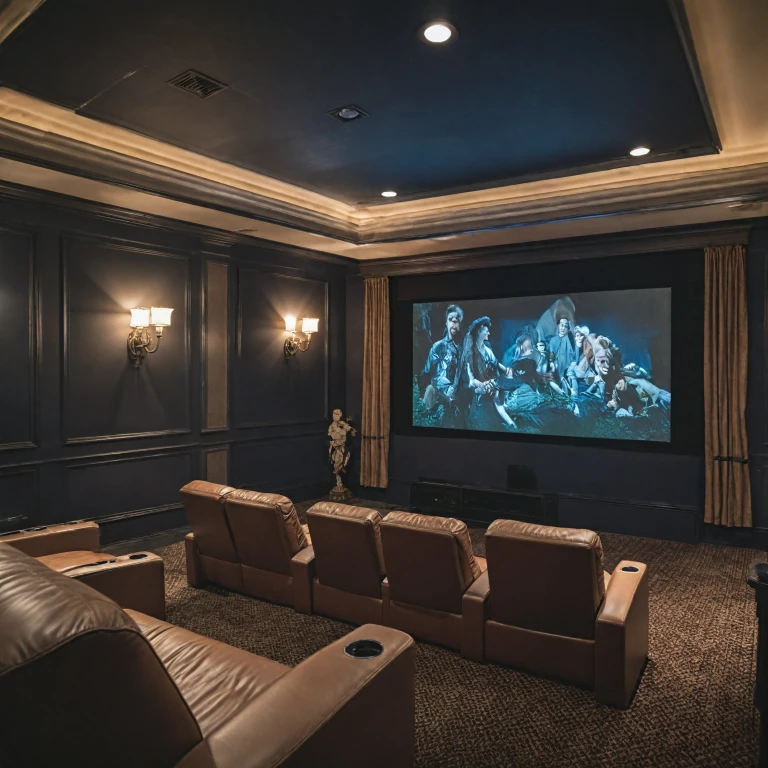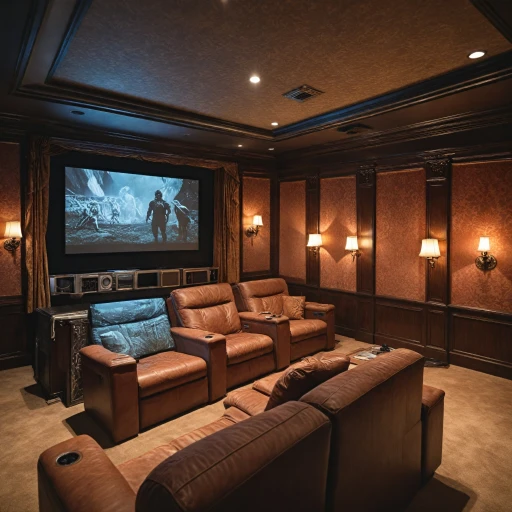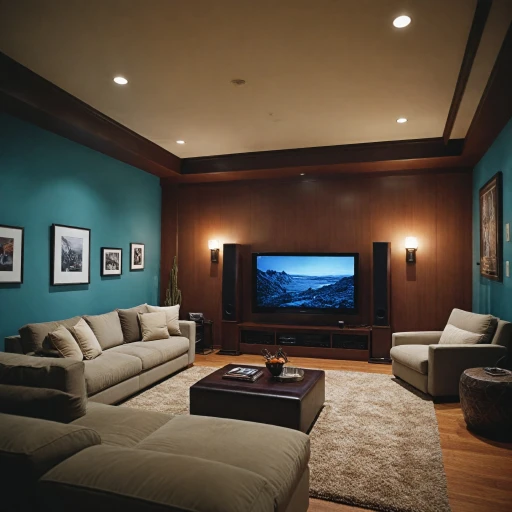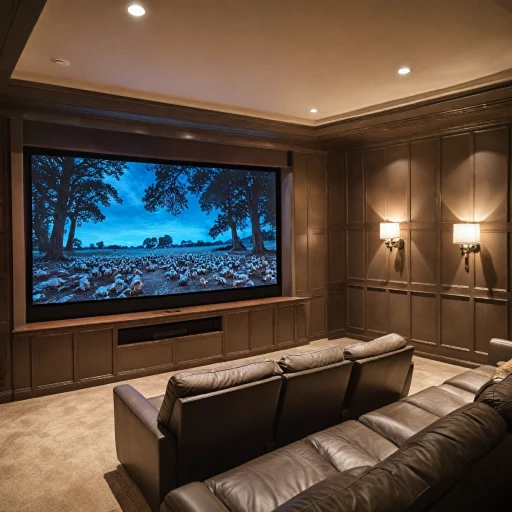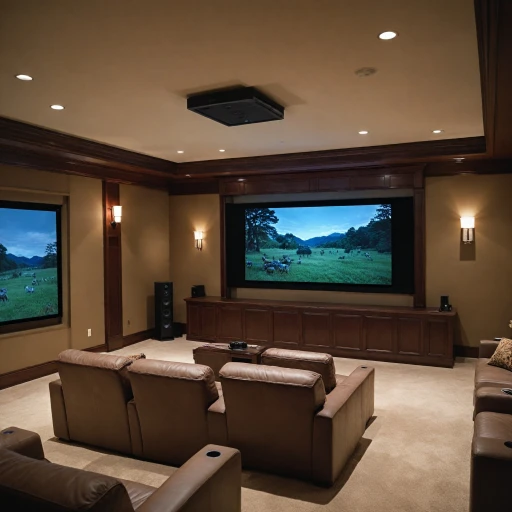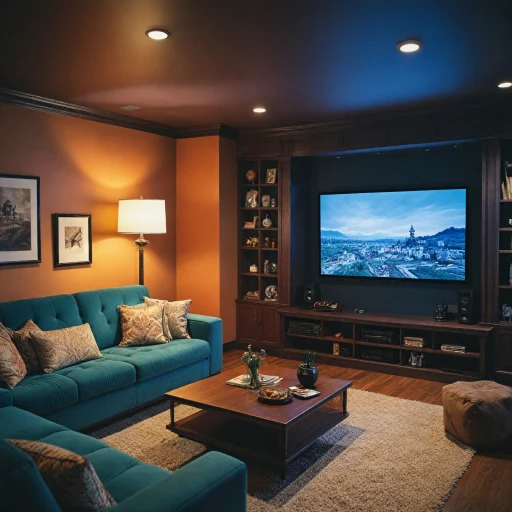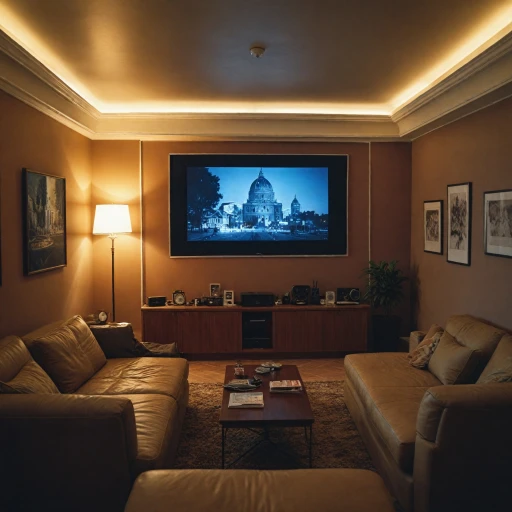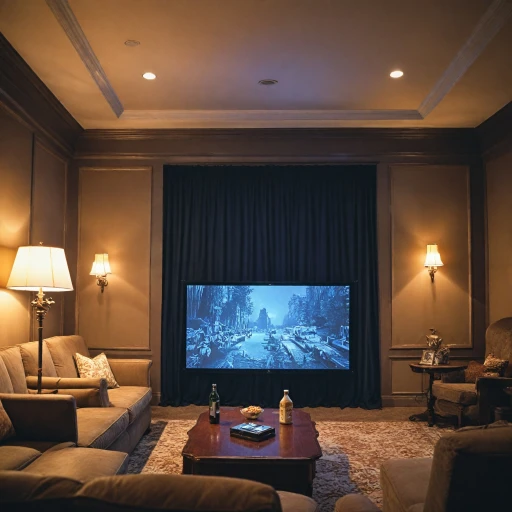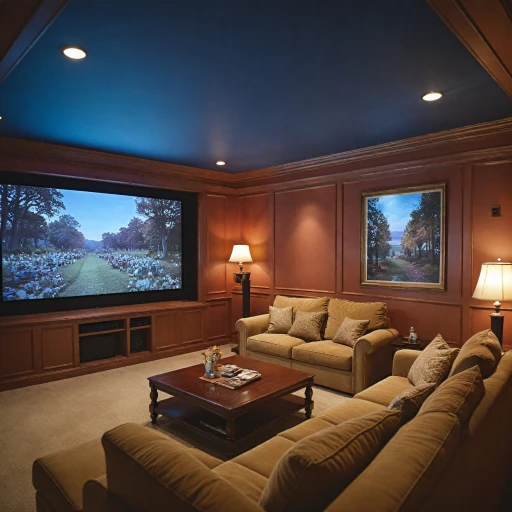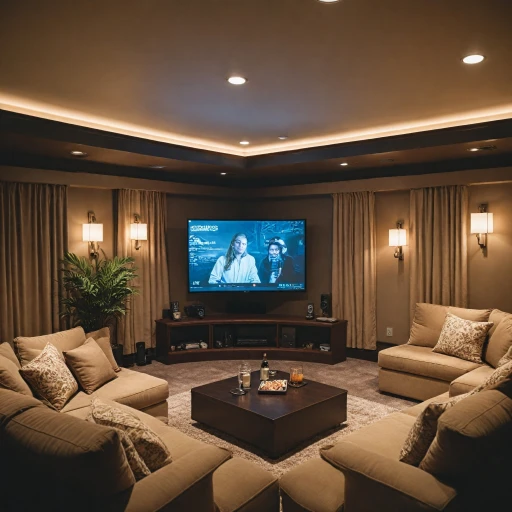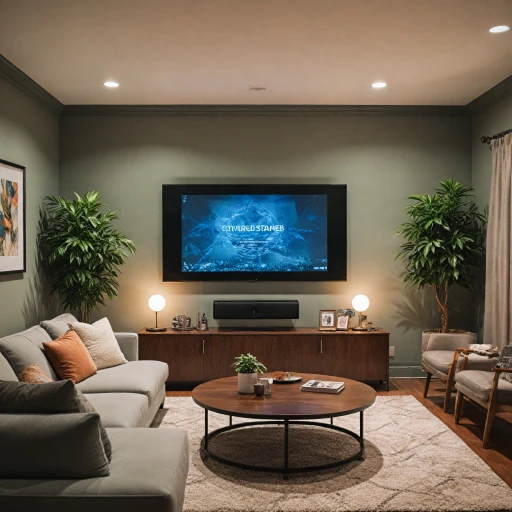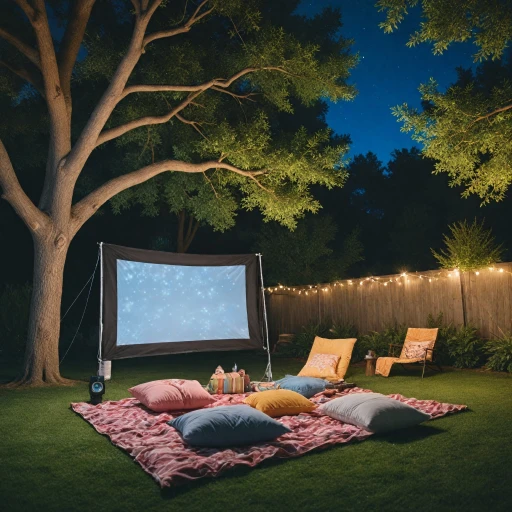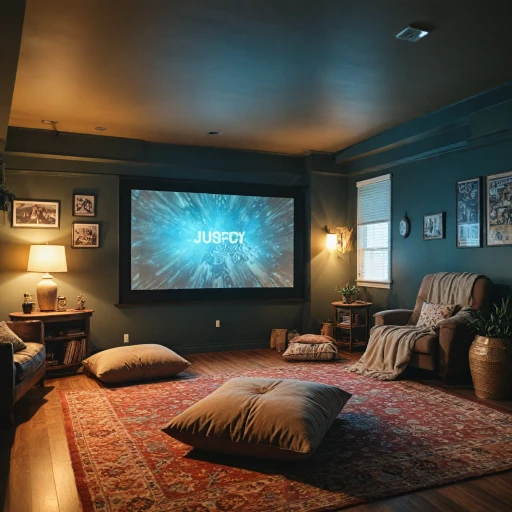
Understanding Motorized Projection Screens
The Fundamentals of a Motorized Projection Screen
The world of home theater is continuously evolving, and motorized projection screens are at the forefront of this change. But what exactly are motorized screens, and why are they gaining popularity?
A motorized projection screen is essentially an electric screen that can be automatically retracted or extended with the push of a button. This functionality offers both convenience and sophistication, lending an element of luxury to your home theater setup.
These screens come in various types and styles, including tab tension and ceiling electric models like the Evanesce Tab and Kestrel Tab. The Elite Screens series is particularly renowned for offering high-quality options that seamlessly integrate into modern home theaters. Whether you’re mounting from the ceiling or opting for a fixed frame, these screens provide flexibility in installation and design.
Motorized projection screens are compatible with different projector types, including short throw projectors, ensuring they fulfill diverse needs and spaces. The screens vary in price, based on features such as screen size, material, and additional functionalities, such as black masking borders and matt white surfaces for optimal display. The VMAX XWS and VMAX XWV series, for example, offer premium options equipped with the latest technology in electric projection screens.
Understanding the fundamental aspects of motorized screens can greatly enhance your viewing experience. For further insights, visit this detailed guide on enhancing your viewing experience with a motorized projector screen. As you explore, you'll discover the unique benefits that make these screens an appealing choice for home theater enthusiasts.
Benefits of a Motorized Projection Screen
The Advantages of Automated Projection Screens
Investing in a motorized projection screen can significantly elevate your home theater experience. Here’s why you should consider making the switch from a manual projection screen to an automated option:- Convenience: Motorized screens provide ease of use with just the push of a button, saving you time and effort. You can often operate these screens with a remote control or integrate them with a smart home system for seamless functionality.
- Sleek Aesthetic: When not in use, a motorized screen can retract into the ceiling or a casing, yielding a clean, clutter-free look in your home theater. This is particularly beneficial for spaces that serve multiple purposes.
- Enhanced Viewing Experience: Some advanced motorized screens, such as the elite screens evanesce tab or saker tab, include tab tension features. These maintain a flat, even surface, minimizing disturbances such as ripples and improving the overall picture quality.
- Customization Options: With various options like the black masking feature or ultra-short throw compatibility, you can optimize your viewing experience to meet specific needs. Fixed frame and ceiling electric options provide additional customizability.
- Durability: High-quality materials and mechanisms like those in screens evanesce or the vmax xws series ensure longevity. The use of materials like matt white and black ensures vivid image projection, while the electric mechanisms are built to last, delivering reliable performance over time.
Choosing the Right Motorized Projection Screen
Factors to Consider When Selecting Your Ideal Screen
Investing in a motorized projection screen can dramatically enhance your home theater experience, but selecting the right one might be daunting. Here's a comprehensive guide to help you make an informed decision.
Evaluate Your Room Setup
First, assess the room where you plan to install the screen. Will the screen be mounted on a ceiling or wall? Consider electric projection options like ceiling electric models for a neat and space-saving installation.
Understand Screen Types and Their Features
- Electric vs. Manual: Electric projection screens, such as those in the elite screens series, offer convenience with remote control operation, unlike manual options.
- Tab Tension: Screens with tab tension reduce wrinkles for a smooth projection surface. Look for elite screens evanesce tab or saker tab models.
- Fixed Frame vs. Retractable: Consider fixed frame setups for a permanent display or retractable screens, which offer flexibility in use.
Consider Screen Material and Color
- Material: Choose between various finishes, such as matt white or specially coated surfaces for enhanced image quality.
- Color: Many screens come with black masking borders to improve the perceived contrast and picture focus.
Budget and Brand Options
Your budget will influence what options are available. Explore models in the vmax or vmax xws series for affordable yet reliable choices. Established brands often provide excellent warranties and customer support for peace of mind.
By considering these factors, you can find a projection screen that fits your specific requirements and enhances your viewing experience. If you're exploring advanced features for projectors and AV receivers, include this angle in your decision-making to fully optimize your home theater setup.
Installation Tips for Motorized Projection Screens
Step-by-Step Guide to Seamless Installation
Installing a motorized projection screen can seem daunting, but with the right approach, it can be done smoothly and efficiently. Here are key installation tips to ensure your screen is set up perfectly:- Choose the Right Mounting Position: Begin by selecting an optimal location for your screen. Ensure it is mounted where the projector can easily cast its image without obstacles. Consider the ceiling or wall, depending on your room's layout.
- Ensure Structural Support: It's important to verify that the installation site can support the weight of the projection screen, especially for larger models like the vmax series. Use wall studs or ceiling joists for secure mounting.
- Use Quality Mounting Kits: Quality mounting kits, which may include tabs and brackets, provide stability for your motorized screen. Some models, like the elite screens, come with their specific installation instructions and components.
- Electric and Cabling Connections: Coordinate with a professional to manage the electric connections needed for your motorized screen. Ensure cabling is secure and considers future connectivity needs for projectors or other devices.
- Calibrate Tensions and Alignments: For tab tension models, adjusting tension settings is crucial for a smooth projection surface. Models like the kesi tab and saker tab may require fine-tuning to ensure flatness and eliminate black masking or distortion.
- Test Before Finalizing: Run a full test of the screen’s motorized operation and positioning. Make sure the screen aligns well with the projector’s output, often utilizing settings like short throw or fixed frame to guarantee optimal viewing quality.
- Integrate the Screen with Your Home Theater Setup: Check that the screen's placement complements your home theater configuration. If needed, make adjustments to the positioning for a more immersive experience, whether using screens evanesce or a ceiling electric installation.
Maintenance and Care for Your Motorized Projection Screen
Essential Maintenance Tips for Your Projection Screen
Maintaining your motorized projection screen is crucial for prolonging its life and ensuring optimal performance. A few regular checks and routine cleanings can make a significant difference.- Regular Cleaning: Dust can accumulate on the screen surface and motor, affecting performance. Use a soft, lint-free cloth to gently clean the screen surface. For stubborn spots, a mild solution of water and soap may be used, but ensure the screen is not wet. Always clean in a circular motion to avoid streaks.
- Inspect the Motor: Since your screen is motorized, periodic inspections of the motor are necessary. Listen for any unusual sounds during operation. If you hear grinding or clicking, consider consulting a professional. Dust around the motor with a small vacuum or a soft brush to prevent buildup.
- Check the Tension: If your screen has a tab tension feature, ensure the tension cords are tight. This prevents wrinkles and delivers a smooth viewing surface. Adjustments can usually be done at the sides of the screen.
- Test the Electric System: Regularly test the electric controls to ensure seamless operation. If there are issues with the remote or wall switch, refer to the troubleshooting section in your screen's manual.
- Avoid Direct Sunlight: Position your screen away from direct sunlight to prevent color fading and material damage. If the installation area cannot be altered, consider using black masking or ceiling materials to control light exposure.
Comparing Motorized and Manual Projection Screens
Pros and Cons of Motorized vs. Manual Projector Screens
When deciding between a motorized and a manual projector screen, there are numerous factors to consider, ranging from cost to convenience. Let's dive into what sets these two options apart.
Convenience and Ease of Use
Motorized projector screens, such as the ceiling electric or tab tension screens, are equipped with an electric mechanism, enabling smooth deployment and retraction with minimal effort. This convenience can enhance your viewing experience by eliminating the need to manually pull down the screen every time you watch a movie.
In contrast, manual screens require manual pulling which might not offer the same level of ease, especially in higher-ceiling installations. However, they provide a straightforward and budget-friendly alternative for users who don't mind a little manual effort.
Price Considerations
Price is a critical factor for many when selecting a projection screen. Motorized screens, including models like the VMAX series, frequently cost more due to the complex mechanics involved. Additionally, features such as tab tension help to ensure a flat viewing surface by reducing curls and waves, which adds to the price.
On the other hand, manual projection screens are generally more affordable and can fit into tighter budgets without sacrificing too much in terms of performance or screen quality.
Installation and Aesthetic Value
Installing a motorized screen often provides a cleaner and more sophisticated look, as these screens can be seamlessly integrated into your ceiling or wall. Models like the screens evanesce or saker tab blend well into your home decor when not in use.
Manual screens, however, may not offer the same sleek, unobtrusive ensemble, though they are typically simpler and quicker to install, making them a suitable option for those looking to set up quickly without major modifications.
Durability and Maintenance
Maintenance often also tilts in favor of motorized screens, as higher-end models like the elite screens often come with features that minimize wear and tear over time, thanks to advanced materials like matt white and specialized components.
Meanwhile, manual screens will require careful handling to prevent damage and ensure longevity, potentially involving more frequent maintenance.
In conclusion, the choice between motorized and manual projector screens ultimately depends on your specific needs, budget, and space. Both can significantly enhance your home theater setup, with motorized screens offering more convenience and a premium feel, while manual screens provide a cost-effective solution.
